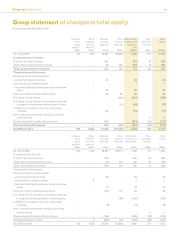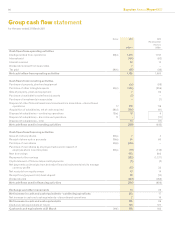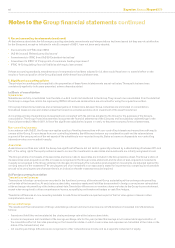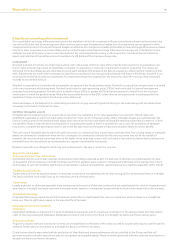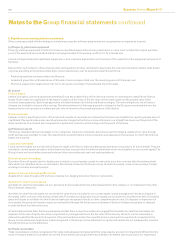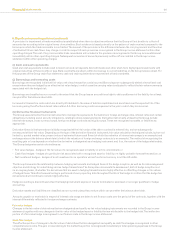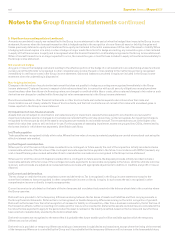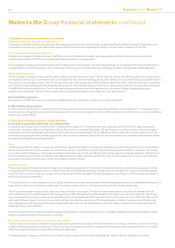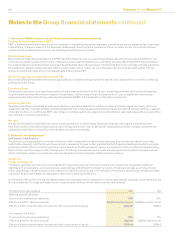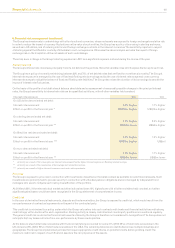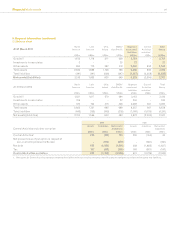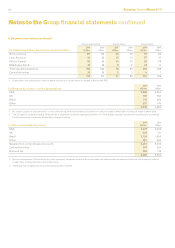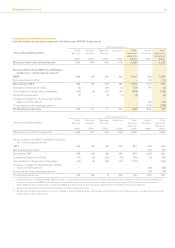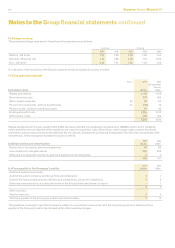Experian 2011 Annual Report Download - page 107
Download and view the complete annual report
Please find page 107 of the 2011 Experian annual report below. You can navigate through the pages in the report by either clicking on the pages listed below, or by using the keyword search tool below to find specific information within the annual report.
Financial statements 105
6. Critical accounting estimates and judgments (continued)
Goodwill
Goodwill is allocated to CGUs and monitored for internal management purposes by operating segment. The allocation is made to those CGUs
or groups of CGUs that are expected to benet from the business combination in which the goodwill arose.
The Group tests goodwill for impairment annually or more frequently if events or changes in circumstances indicate that the goodwill may be
impaired. The recoverable amount of each CGU is generally determined on the basis of value-in-use calculations which require the use of cash
ow projections based on nancial budgets approved by management, looking forward up to ve years. Management determines budgeted
gross margin based on past performance and its expectations for the market development. Cash ows are extrapolated using estimated growth
rates beyond a ve year period. The growth rates used do not exceed the long-term average growth rate for the markets in which the segment
operates. The discount rates used reect the segment’s weighted average cost of capital (‘WACC’).
The key assumptions used for value-in-use calculations are:
2011 2010
CGU
Pre-tax
WACC
%
Long-term
growth rate
%
Pre-tax
WACC
%
Long-term
growth rate
%
North America 12.7 2.3 12.2 2.3
Latin America 16.4 6.7 15.4 6.4
UK and Ireland 10.4 2.3 10.5 2.3
EMEA 11.2 4.3 9.8 4.3
Asia Pacic 12.0 5.1 11.6 4.8
At 31 March 2011, the recoverable amount of the Latin America CGU exceeds the carrying value by approximately US$800m and an increase
in the pre-tax WACC of 4.8% would reduce the value-in-use of its goodwill to an amount equal to its carrying value. At 31 March 2011, the
recoverable amount of the Asia Pacic CGU exceeds the carrying value by approximately US$100m and an increase in the pre-tax WACC of
2.5% or a reduction of 3.9% in the long-term growth rate would reduce the value-in-use of its goodwill to an amount equal to its carrying value.
The recoverable amount of the other CGUs exceed their carrying value on the basis of the above assumptions and any reasonably possible
changes thereof.
Share-based payments
The assumptions used in determining the amounts charged in the Group income statement include judgments in respect of performance
conditions and length of service together with future share prices, dividend and interest yields and exercise patterns.
(b) Critical judgments
Management has made certain judgments in the process of applying the Group’s accounting policies that have a signicant effect on the
amounts recognised in the Group nancial statements. These judgments include the classication of transactions between the Group income
statement and the Group balance sheet.
The most signicant of these judgments is in respect of intangible assets where certain costs incurred in the developmental phase of an internal
project are capitalised if a number of criteria are met. Management has made certain judgments and assumptions when assessing whether a
project meets these criteria, and on measuring the costs and the economic life attributed to such projects. On acquisition, specic intangible
assets are identied and recognised separately from goodwill and then amortised over their estimated useful lives. These include such items
as brand names and customer lists, to which value is rst attributed at the time of acquisition. The capitalisation of these assets and the
related amortisation charges are based on judgments about the value and economic life of such items. The economic lives for intangible assets
are estimated at between three and ten years for internal projects, which include databases, internal use software and internally generated
software, and between two and twenty years for acquisition intangibles.
7. Use of non-GAAP measures in the Group nancial statements
The Group has identied certain measures that it believes will assist understanding of the performance of the business. The measures are
not dened under IFRS and they may not be directly comparable with other companies’ adjusted measures. The non-GAAP measures are not
intended to be a substitute for, or superior to, any IFRS measures of performance but management has included them as they consider them to
be important comparables and key measures used within the business for assessing performance.
The following are the key non-GAAP measures identied by the Group and used in the Group nancial statements:
Benchmark prot before tax (‘Benchmark PBT’)
Benchmark PBT is dened as prot before amortisation of acquisition intangibles, acquisition expenses, goodwill impairments, adjustments
to contingent consideration, charges in respect of the demerger-related equity incentive plans, exceptional items, nancing fair value
remeasurements, tax and discontinued operations. It includes the Group’s share of continuing associates’ pre-tax results.


